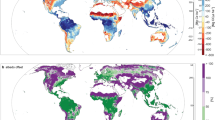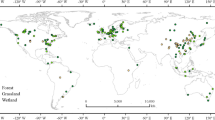Abstract
Blanket bog is a highly distinctive biome restricted to disjunct hyperoceanic regions. It is characterized by a landscape covering of peat broken only by the steepest slopes1. Plant and microbial life are adapted to anoxia, low pH and low nutrient availability. Plant productivity exceeds soil organic matter decomposition, so carbon is sequestered over time. Unique climatic requirements, including high year-round rainfall and low summer temperatures2, make this biome amenable to bioclimatic modelling. However, projections of the fate of peatlands in general, and blanket bogs in particular, under climate change have been contradictory3,4,5,6,7. Here we use a simple, well-founded global bioclimatic model8, with climate-change projections from seven climate models, to indicate this biome’s fate. We show marked shrinkage of its present bioclimatic space with only a few, restricted areas of persistence. Many blanket bog regions are thus at risk of progressive peat erosion and vegetation changes as a direct consequence of climate change. New areas suitable for blanket bog are also projected, but these are often disjunct from present areas and their location is inconsistently predicted by different climate models.
This is a preview of subscription content, access via your institution
Access options
Subscribe to this journal
Receive 12 print issues and online access
$209.00 per year
only $17.42 per issue
Buy this article
- Purchase on Springer Link
- Instant access to full article PDF
Prices may be subject to local taxes which are calculated during checkout




Similar content being viewed by others
References
Charman, D. J. Peatlands and Environmental Change Ch. 1, 3–23 (Wiley, 2002).
Wieder, R. K. & Vitt, D. H. Boreal Peatland Ecosystems (Springer, 2006).
Bragazza, L. A climatic threshold triggers the die-off of peat mosses during an extreme heat wave. Glob. Change Biol. 14, 2688–2695 (2008).
Crawford, R. M. M., Jeffree, C. E. & Rees, W. G. Paludification and Forest Retreat in Northern Oceanic Environments. Ann. Bot. 91, 213–226 (2003).
Gignac, L. D., Nicholson, B. J. & Bayley, S. E. The utilization of bryophytes in bioclimatic modeling: Predicted northward migration of peatlands in the Mackenzie River Basin, Canada, as a result of global warming. Bryologist 101, 572–587 (1998).
Ise, T., Dunn, A. L., Wofsy, S. C. & Moorcroft, P. R. High sensitivity of peat decomposition to climate change through water-table feedback. Nature Geosci. 1, 763–766 (2008).
Ellis, C. J. & Tallis, J. H. Climatic control of blanket mire development at Kentra Moss, north-west Scotland. J. Ecol. 88, 869–889 (2000).
Gallego-Sala, A. V. et al. Bioclimatic envelope model of climate change impacts on blanket peatland distribution in Great Britain. Clim. Res. 45 (Uplands Special Issue), 151–162 (2010).
Moore, P. D. The future of cool temperate bogs. Environ. Conserv. 29, 3–20 (2002).
Laine, A., Byrne, K., Kiely, G. & Tuittila, E.-S. Patterns in vegetation and CO2 dynamics along a water level gradient in a lowland blanket bog. Ecosystems 10, 890–905 (2007).
Davis, A. M. Ombrotrophic peatlands in Newfoundland, Canada: Their origins, development and trans-Atlantic affinities. Chem. Geol. 44, 287–309 (1984).
Kleinebecker, T., Hölzel, N. & Vogel, A. Patterns and gradients of diversity in South Patagonian ombrotrophic peat bogs. Aust. Ecol. 35, 1–12 (2010).
Whinam, J. & Hope, G. S. in Moore—Von Sibirien Bis Feuerland (Biologiezentrum der Oberöesterreichischen Landesmuseen Neue Serie, Vol. 35, Biologiezentrum der Oberösterreichischen Landesmuseen, 2005).
Ringeval, B. et al. An attempt to quantify the impact of changes in wetland extent on methane emissions on the seasonal and interannual time scales, under review. Glob. Biogeochem. Cycles 24, GB2003 (2010).
Gignac, L. D., Nicholson, B. J. & Bayley, S. E. The utilization of bryophytes in bioclimatic modeling: Present distribution of peatlands in the Mackenzie River Basin, Canada. Bryologist 101, 560–571 (1998).
Gignac, L. D., Halsey, L. A. & Vitt, D. H. A bioclimatic model for the distribution of Sphagnum-dominated peatlands in North America under present climatic conditions. J. Biogeogr. 27, 1139–1151 (2000).
Parviainen, M. & Luoto, M. Climate envelopes of mire complex types in Fennoscandia. Geografis. Ann. Ser. A 89A, 137–151 (2007).
Kleinen, T., Brovkin, V. & Schuldt, R. J. A dynamic model of wetland extent and peat accumulation: Results for the Holocene. Biogeosciences 9, 235–248 (2012).
Clark, J. et al. Assessing the vulnerability of blanket peat to climate change using an ensemble of statistical bioclimatic envelope models. Clim. Res. 45 (Uplands Special Issue), 131–150 (2010).
Natural Environment Research Council. QUEST Global-Scale Impacts (GSI) of Climate Change: An Integrated Multi-Sectoral Assessment. Accessed 2009. (NCAS British Atmospheric Data Centre, 2008); available via http://go.nature.com/pxtlJa.
Woike, M. & Schmatzler, E. Moore. Bedeutung-Schutz-Regeneration. In Lindsay (2009) Peatlands and Carbon—A Critical Synthesis to Inform Policy Development. A Report for Discussion, (Deutscher Naturschutzring, 1980).
Sykes, M. T., Prentice, I. C. & Cramer, W. A bioclimatic model for the potential distributions of North European tree species under present and future climates. J. Biogeogr. 23, 203–233 (1996).
UNEP World Atlas of Desertification (United Nations Environment Programme, 1992).
Prentice, I. C., Sykes, M. T. & Cramer, W. The possible dynamic response of northern forests to global warming. Glob. Ecol. Biogeogr. Lett. 1, 129–135 (1991).
Kaplan, J. O. et al. Climate change and Arctic ecosystems: 2. Modeling, paleodata-model comparisons, and future projections. J. Geophys. Res. 108, 8171 (2003).
Leemans, R. & Cramer, W. The IIASA Database for Mean Monthly Values of Temperature, Precipitation and Cloudiness of A Global Terrestrial Grid. Report RR-91-18 (IIASA, 1991).
IPCC Climate Change 2007: The Physical Science Basis (eds Solomon, S. et al.) (Cambridge Univ. Press, 2007).
Mitchell, T. D. & Osborn, T. J. ClimGen: A flexible Tool for Generating Monthly Climate Data Sets and Scenarios. Tyndall Centre for Climate Change Research Working Paper (in preparation 2005).
Mitchell, T. D., Carter, T. R., Jones, P. D. & Hulme, M. A Comprehensive Set of High-Resolution Grids of Monthly Climate for Europe and the Globe: The Observed Record (1901–2000) and 16 Scenarios (2001–2100). Tyndall Centre Working Paper No.55, Tyndall Centre (2004).
Acknowledgements
We are grateful to the Environment Agency (Science project sc070036) and the Natural Environment Research Council (NERC), through the Quantifying and Understanding the Earth System (QUEST) programme, for funding the development of PeatStash. M. Sykes at Lund University provided the STASH code, and F. Bragg at Bristol helped with the climate-change scenarios. Climate-change scenarios were provided by the QUEST GSI project, funded by NERC. We are indebted to J. Hecht, B. Ridge, S. Velásquez-Franco, R. Limeres and M. Rimmer for providing pictures of blanket bogs.
Author information
Authors and Affiliations
Contributions
A.V.G.S. carried out model runs and analysis and wrote the first draft. I.C.P. supervised the project and contributed to experimental design, interpretation of results, and the final draft.
Corresponding author
Ethics declarations
Competing interests
The authors declare no competing financial interests.
Supplementary information
Supplementary Information
Supplementary Information (PDF 271 kb)
Rights and permissions
About this article
Cite this article
Gallego-Sala, A., Colin Prentice, I. Blanket peat biome endangered by climate change. Nature Clim Change 3, 152–155 (2013). https://doi.org/10.1038/nclimate1672
Received:
Accepted:
Published:
Issue Date:
DOI: https://doi.org/10.1038/nclimate1672
This article is cited by
-
Application of a GIS-Based Hydrological Model to Predict Surface Wetness of Blanket Bogs
Wetlands (2024)
-
Ecological resilience of restored peatlands to climate change
Communications Earth & Environment (2022)
-
Net carbon dioxide emissions from an eroding Atlantic blanket bog
Biogeochemistry (2022)
-
Microtopographic Drivers of Vegetation Patterning in Blanket Peatlands Recovering from Erosion
Ecosystems (2019)
-
Mapping Mountain Peatlands and Wet Meadows Using Multi-Date, Multi-Sensor Remote Sensing in the Cordillera Blanca, Peru
Wetlands (2019)



